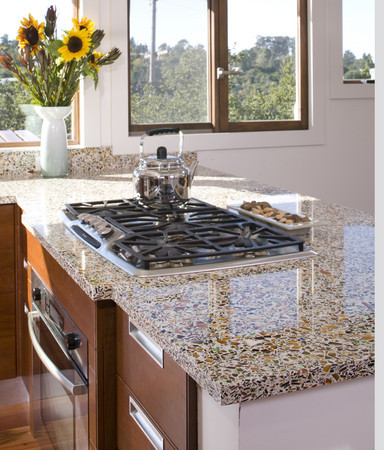Second time
Each week you faithfully sort your glass, plastic, aluminum and paper for recycling. Most of us, however, have never given another thought to what happens to those materials once they are picked up through the curbside recycling program or taken to the local recycling center.
Thanks to environmentally conscious manufacturers, many materials find second lives as products that help beautify our homes.
"Our product is fully 85 percent recycled material, and much of that is post-consumer recycled material," said Karen Righthand, director of marketing for Vetrazzo, which manufactures countertops made of recycled glass. "We are literally taking something out of someone's trash, out of the curbside recycling bin and taking that glass and upcycling it."
According to Righthand, upcycling is taking a used material and transforming it into a product that is better than its original form whereas recycling is taking a material and creating something of similar or lesser value.
To create Vetrazzo, assorted pieces of glass are blended with Portland cement to form countertops that can be used in kitchens and bathrooms. The countertops are twice as strong as granite and perform much the same in their resistance to heat, scratching and stains.
Righthand said 85 percent of the new countertops are glass, qualifying them as one of the greenest products available on today's marketplace.
Whenever possible, consumers are told where the glass for their countertops comes from. "It's really cool for the homeowner to know that the bottles in their countertop came from Skyy vodka bottles or green beer, wine and mineral water bottles. We always try to close the loop so they know how much of an impact recycling a bottle really has," Righthand said.
"The glass that Vetrazzo uses is only waste glass. It's always unprocessed, never remelted," she said, adding that the glass does sometimes have to be crushed to the right size.
In addition to curbside recycling programs, the Richmond, Calif.-based manufacturer purchases its glass from a few admittedly odd sources. For example, the company recently received red glass from an airport in San Jose, Calif. The glass domes once covered runway lights and were being replaced by acrylic covers. Other unusual sources of red glass include a shipment of misformed wine goblets and old lenses from traffic lights.
Righthand said one of the benefits of using the glass for their countertops is that it takes very little energy to transform it. Although glass is infinitely recyclable with little to no loss of quality, it takes a great deal of energy to remelt and reform it.
"It's a little like baking a cake," she said of the process to create the countertops, which are currently available in 19 color palettes. "We take the glass, the cement and some water. It's poured into a mold, baked like a cake and polished."
Even the factory where Vetrazzo is made is environmentally conscious. The company occupies a former Ford auto plant and uses daylighting and solar energy lighting.
Recycled plastics, such as milk jugs and soda bottles, are used by Eagle One to create Greenwood, a plastic lumber that is then formed into a variety of chairs, tables, benches, storage boxes and planters.
Originally, the Anaheim, Calif.-based company manufactured Greenwood products for golf courses, said John Rowe, general manager. He said golf course management was looking for an extremely durable material that could withstand the elements as well as abuse from unhappy golfers. When course superintendents saw how well the Greenwood products performed, they asked the company to begin making items for their own homes.
Rowe said they began with a small line of residential products about five years ago and are now using 100 percent recycled plastics to create their outdoor furnishings.
The old plastic jugs and bottles are chipped into little flakes, washed and thrown into a big vat where they are melted. Once melted, colorants and ultraviolet ray inhibitors are added before the Play-Doh-like mixture is extruded into shape.
"Recycled plastic won't chip, rot, split or ever need painting," he said. "There's virtually no maintenance on it."
Other benefits include it being impervious to boring insects and resistant to graffiti.
Rowe said Greenwood is similar in cost to teak, and should pay for itself in about five years. "Using plastic lumber rather than hardwoods is practical and has significant environmental advantages. It's taking material out of our dumps and we're not using virgin materials."
He said the biggest disadvantages of creating new products out of recycled materials are making things consumers can use and the cost. "You have to try to have harmony between the two. If people won't buy it, then it doesn't matter."
Environmental Furniture is trying to blur that line by creating products that people use every day. Its wooden tables, chairs and bed frames are made from reclaimed wood from old barns and buildings. Other recycled materials include reclaimed truck top canvasses from Brazil, vintage Levi jeans and old telephone poles.
One of its newest creations is upholstered pieces made out of old, abandoned military tents.
"We have discovered that these durable cotton fabrics, that have been softened by time and usage, are great upholstery material," said Davide Berruto, CEO of the Los Angeles-based company that operates a showroom at the Las Vegas Design Center. "The organic dyes applied to them transform the original olive green color to beautiful shades of indigo, eggplant, smoke gray, Havana brown and dark green."
Used by the U.S. Army since the Civil War, the two-man pup tent is comprised of two shelter halves. The pieces fasten together with a row of buttons or snaps along the ridgeline, which have to be removed before they are transformed into sofas and chairs. The faded stamps that say US Army, however, remain.






















